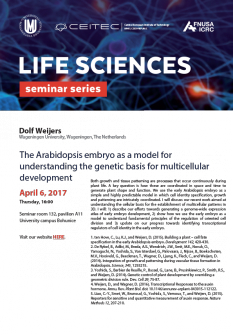Both growth and tissue patterning are processes that occur continuously during plant life. A key question is how these are coordinated in space and time to generate plant shape and function. We use the early Arabidopsis embryo as a simple and highly predictable model in which cell identity specification, growth and patterning are intricately coordinated. I will discuss our recent work aimed at understanding the cellular basis for the establishment of multicellular patterns in 3D. I will: 1) describe our efforts towards generating a genome-wide expression atlas of early embryo development, 2) show how we use the early embryo as a model to understand fundamental principles of the regulation of oriented cell division and 3) update on our progress towards identifying transcriptional regulators of cell identity in the early embryo.
1. ten Hove, C., Lu, K.J., and Weijers, D. (2015). Building a plant – cell fate specification in the early Arabidopsis embryo. Development 142, 420-430.
2. De Rybel, B., Adibi, M., Breda, A.S., Wendrich, J.W., Smit, M.E., Novak, O., Yamaguchi, N., Yoshida, S., Van Isterdael, G., Palovaara, J., Nijsse, B., Boekschoten, M.V., Hooiveld, G., Beeckman, T., Wagner, D., Ljung, K., Fleck, C., and Weijers, D. (2014). Integration of growth and patterning during vascular tissue formation in Arabidopsis. Science, 345, 1255215.
3. Yoshida, S., Barbier de Reuille, P., Bassel, G., Lane, B., Prusinkiewicz, P., Smith, R.S., and Weijers, D. (2014). Genetic control of plant development by overriding a geometric division rule. Dev. Cell 29, 75-87.
4. Weijers, D., and Wagner, D. (2016). Transcriptional Responses to the auxin hormone. Annu. Rev. Plant Biol. doi: 10.1146/annurev-arplant-043015-112122.
5. Liao, C.-Y., Smet, W., Brunoud, G., Yoshida, S., Vernoux, T., and Weijers, D. (2015). Reporters for sensitive and quantitative measurement of auxin response. Nature Methods 12, 207-210.








